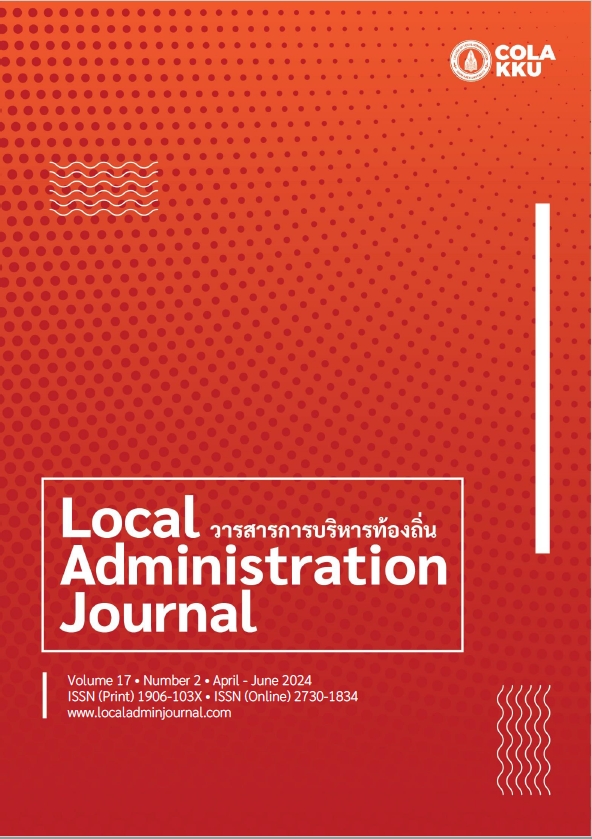Empowering Citizens to Enhance Quality of Life: The “Public Sphere” Initiative in Suphan Buri Province
Keywords:
public sphere, deliberative democracy, participatory democracy, empowered communitiesAbstract
The public sphere stands as the cornerstone of deliberative democracy, aiming to address the deficiencies of representative democracy. Positioned between the state and society, it serves to strike a balance between stability and social evolution. This platform fosters discussions, debates on public issues, and scrutiny of the state’s activities. The action research project “Empowering Community Resilience on the basis of the Thai Democratic Regime by Social Innovation” employs a participatory action research approach. It emphasizes collaborative learning, involving the research team, pilot provincial community organizations, development support organizations, and stakeholders across sectors. The objective is to fortify communities and advocate for a central community forum. The selection of pilot communities across five provinces considered their readiness. This article presents the outcomes of activities undertaken during the initial year in Suphan Buri province. The research team engaged in a central forum, facilitating the exchange of views and consultations among the community organization network and leaders of the Council of Community Organizations and the Civil Society Sector. Together, they established development objectives under the “One Goal” concept, addressing pressing needs related to the quality of life across five domains: economics, health, education, welfare, and residential aspects in Suphan Buri Province
References
Alinsky, S. (1989). Rules for radicals: A pragmatic primer for realistic radicals. New York, NY: Vintage.
Bramley, G., & Power, S. (2009). Urban form and social sustainability: The role of density and housing type. Environment and Planning B: Planning and Design, 36(1), 30-48.
Brown, R. B., Xu, X., Barfield, M. A., & King, B. G. (2000). Community experience and the conceptual distinctness of rural community attachment and satisfaction. Research in Community Sociology, 10, 421-446.
Castells, M. (2008). The new public sphere: Global civil society, communication networks, and global governance. The Annals of the American Academy of Political and Social Science, 616(1), 78-93.
Cope, M. R., Flaherty, J., Young, K. D., & Brown, R. B. (2015). Olympic boomtown: The social impacts of a one-time mega-event in Utah's Heber Valley. Sociological Spectrum, 35(2), 136-160.
Eizenberg, E., & Jabareen, Y. (2017). Social sustainability: A new conceptual framework. Sustainability, 9(1), 68.
Goodsell, T. L., Flaherty, J., & Brown, R. B. (2010). Community as moral proximity: Theorizing community in a global economy. Rural America in a Globalizing World: Problems and Prospects for the, 626-641.
Habermas, J. (1996). Between facts and norms: Contributions to a discourse theory of law and democracy. John Wiley & Sons.
Habermas, J. (2020). The public sphere: An encyclopedia article. In Critical Theory and Society (pp. 136-142). Routledge.
Habermas, J. (1991). The structural transformation of the public sphere: An inquiry into a category of bourgeois society. MIT Press.
Isariyanon, M., Isariyanon, S., & Silakorn, S. (2021). Community development of community strength to self-organization community of Thung Pho Sub-district, Na Di District, Prachin Buri Province. Nakhon Lampang Buddhist College’s Journal, 10(2), 15–30. (in Thai)
Ismail, M. (2009). Corporate social responsibility and its role in community development: An international perspective. Journal of International Social Research, 2(9), 199-209.
Kaewthep, K. (1995). Working in a community cultural way with human beings at the center. Catholic Council of Thailand for Development. (in Thai)
Kleinstüber, H. J. (2001). Habermas and the public sphere: From a German to a European perspective. Javnost - The Public, 8(1), 95-108.
Phillips, R., & Pittman, R. (2008). An introduction to community development. New York, NY: Routledge.
Promgird, P. (2013). Political sociology. Faculty of Humanities and Social Sciences, Khon Kaen University. (in Thai)
Samukkethum, S. (2015). Community, individuality, and development in the globalization era. Journal of Social Development and Management Strategy, 17(1), 1–27. (in Thai)
Samukkethum, S. (2023). Community empowerment and sustainable development. National Institute of Development Administration. (in Thai)
Sommerfeldt, E. J. (2013). The civility of social capital: Public relations in the public sphere, civil society, and democracy. Public Relations Review, 39(4), 280-297.
Suphanburi Provincial Statistical Office. (2021). Suphan Buri provincial statistical report: 2021. Suphanburi, Thailand: Suphan Buri Provincial Statistical Office. (in Thai)
Downloads
Published
How to Cite
Issue
Section
License
Copyright (c) 2024 Local Administration Journal

This work is licensed under a Creative Commons Attribution-NonCommercial-NoDerivatives 4.0 International License.
The copyright of all articles published in the Local Administration Journalis owned by the College of Local Administration, Khon Kaen University.



